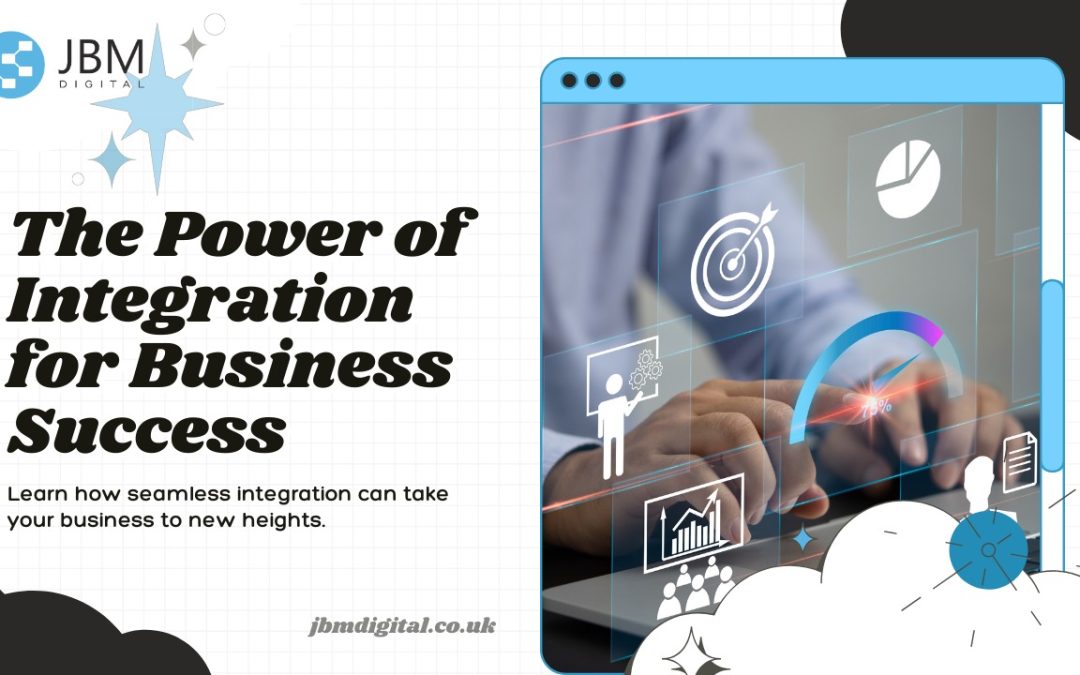
by JBM Digital | Jan 15, 2024 | Integration
Unlocking Efficiency: Best System Integration Practices for UK Businesses.

Photo by fauxels from Pexels
As businesses in the UK continue to grow and evolve, the need for efficient and streamlined processes becomes increasingly important. One way to achieve this is through system integration. System integration is the process of connecting different software applications and systems within an organization to ensure seamless communication and data flow.
In this article, we will explore why system integration matters, the challenges businesses face when implementing it, the key benefits of an effective system integration strategy, and how to choose and implement the right integration plan.
System integration plays a crucial role in enhancing productivity and efficiency within an organization. By integrating various systems and applications, businesses can eliminate manual data entry, reduce errors, and improve overall workflow. A well-integrated system allows for real-time data sharing, which enables faster decision-making and better collaboration among teams. Additionally, system integration enhances customer experience by providing a unified view of customer data, enabling personalized interactions and smoother transactions.
Challenges of system integration
While the benefits of system integration are undeniable, businesses often encounter challenges when implementing it.
- One common challenge is the complexity of integrating different systems that may have been developed at different times and using different technologies. This can lead to compatibility issues and require significant effort to ensure seamless integration.
- Additionally, data security and privacy concerns arise when integrating systems that handle sensitive information. It is essential to have robust security measures in place to protect data from unauthorized access or breaches.
- Another challenge is the resistance to change from employees who are accustomed to working with existing systems. Training and change management efforts are crucial to ensure the successful adoption of the new integrated system.
- Finally, budget and resource constraints can pose challenges when implementing system integration. It is essential to carefully plan and allocate resources to avoid cost overruns and delays.
Key Benefits of an Effective System Integration
Implementing an effective system integration strategy offers numerous benefits to UK businesses. Firstly, it improves efficiency by automating processes and reducing manual data entry. This frees up employees’ time, allowing them to focus on more value-added tasks.

Photo by Christina Morillo from Pexels:
Secondly, system integration enhances data accuracy by eliminating errors that can occur during manual data transfer. With real-time data synchronization, businesses can make informed decisions based on reliable and up-to-date information.
Thirdly, system integration enables better collaboration among teams. With integrated systems, different departments can access and share data seamlessly, leading to improved communication and coordination. This promotes a more cohesive and productive work environment. Additionally, system integration enhances customer satisfaction by providing a unified view of customer data. This enables businesses to deliver personalized experiences and tailored solutions, resulting in increased customer loyalty.
Choosing the Right Integration Strategy
Selecting the appropriate integration strategy is crucial for successful implementation. The choice will depend on factors such as the complexity of existing systems, business requirements, and available resources.
- One common integration strategy is point-to-point integration, where systems are directly connected to exchange data. This approach is suitable for simple integrations but can become complex and challenging to maintain as the number of systems increases.
- Another strategy is the use of middleware or integration platforms that act as a central hub, connecting multiple systems. This approach provides flexibility and scalability, allowing businesses to add or remove systems easily. It also enables data transformation and orchestration, simplifying the integration process.
Cloud-based integration platforms offer additional benefits such as cost-effectiveness and easy access to data from anywhere.
Implementing a System Integration Plan
To successfully implement a system integration plan, several key steps must be followed.
- Firstly, it is essential to conduct a thorough assessment of existing systems and business requirements. This analysis will help identify integration needs, potential challenges, and desired outcomes. Based on this assessment, a detailed integration plan should be developed, outlining the integration strategy, timeline, and resource allocation.
- Next, it is crucial to ensure data security and privacy by implementing robust security measures. This includes encrypting sensitive data, implementing access controls, and regularly monitoring and auditing system activities.
- Adequate training and change management efforts should also be planned to facilitate the smooth adoption of the integrated system. Employees should be provided with the necessary knowledge and support to navigate and utilize the new system effectively.
- Regular monitoring and testing of the integrated system are vital to identify and resolve any issues or performance bottlenecks. This includes conducting regular data integrity checks, performance testing, and user acceptance testing.
Ongoing maintenance and updates should be performed to ensure the system remains secure and optimized.
Conclusion
System integration is a powerful tool for unlocking efficiency and streamlining business processes in the UK. By connecting different systems and applications, businesses can achieve real-time data sharing, automate processes, and improve overall productivity. While challenges may arise during implementation, careful planning, robust security measures, and effective change management can ensure a successful integration. By choosing the right integration strategy and following a well-defined plan, businesses can reap the numerous benefits of system integration and stay ahead in the competitive UK market.
CTA: Contact us today @Jbm Digital to learn more about how system integration can transform your business and unlock new levels of efficiency.

by JBM Digital | Jan 8, 2024 | Integration

Image Source: Unsplash
Introduction to Integration in the Business World
Integration has become a fundamental aspect of success in today’s business landscape. In a world that is becoming increasingly connected, businesses must adapt and find ways to leverage the power of integration to thrive. Integration is the process of combining different aspects of a business, such as departments, technologies, and systems, to create a seamless and efficient operation. It allows businesses to break down silos, streamline processes, and improve overall performance. In this article, we will explore the benefits of integration, real-life examples of successful integration, key strategies for implementation, challenges to overcome, the role of technology, the impact on customer experience, and how to measure success. By embracing integration, businesses can position themselves for future success in the UK and beyond.
Benefits of Integrating Different Aspects of a Business
When businesses integrate different aspects of their operations, they unlock a range of benefits. Firstly, integration improves efficiency by eliminating duplicate or unnecessary processes. By streamlining operations, businesses can reduce costs, save time, and improve productivity. For example, a retail store that integrates its inventory management system with its point-of-sale system can automate inventory updates, reduce manual errors, and improve stock management.
Integration also enables better communication and collaboration among different departments. When information flows seamlessly between teams, decision-making becomes faster and more informed. For instance, a manufacturing company that integrates its production and sales departments can ensure that production aligns with customer demand, leading to optimized inventory levels and increased customer satisfaction.
Furthermore, integration allows businesses to gain a holistic view of their operations. By integrating data from various sources, such as sales, marketing, and customer service, businesses can analyze trends, identify opportunities, and make data-driven decisions. This holistic view enables businesses to be more agile and responsive to market changes, giving them a competitive edge.
Real-Life Examples of Successful Business Integration
Several businesses have successfully implemented integration strategies to drive their growth and success. One notable example is Amazon. Through its integration of various services and departments, Amazon has created a seamless customer experience. From browsing products to making purchases and receiving timely deliveries, Amazon has integrated its entire supply chain to provide a frictionless shopping experience.
Another example is Tesla, the electric car manufacturer. Tesla has integrated its manufacturing, software, and energy storage systems, allowing for efficient production, remote software updates, and innovative energy solutions. This integration has enabled Tesla to disrupt the automotive industry and become a market leader in electric vehicles.
These examples highlight how integration can transform businesses and industries, setting them apart from their competitors and driving growth.
Key Strategies for Implementing Integration Within a Business
Implementing integration within a business requires careful planning and execution. Here are some key strategies to consider:
- Define clear objectives: Before embarking on integration, businesses must clearly define their objectives and what they aim to achieve. Whether it’s improving efficiency, enhancing customer experience, or driving innovation, having clear objectives will guide the integration process.
- Identify integration opportunities: Businesses should assess their operations and identify areas where integration can bring the most value. This could involve integrating systems, processes, or departments that currently operate in isolation.
- Engage stakeholders: Successful integration requires buy-in and involvement from all stakeholders. Engage employees, department heads, and key decision-makers to ensure alignment and support throughout the process.
- Develop an integration plan: Create a detailed plan that outlines the steps, timelines, and resources required for integration. This plan should address potential challenges and include contingency measures.
- Invest in technology: Technology plays a vital role in integration. Businesses should invest in tools and systems that enable seamless data sharing, process automation, and cross-functional collaboration.
- Train and educate employees: Integration often involves changes in processes and workflows. Provide training and education to employees to ensure they understand the benefits of integration and how to navigate the new integrated landscape.
By following these strategies, businesses can successfully implement integration and reap its benefits.
Overcoming Challenges in the Integration Process
Implementing integration within a business is not without its challenges. Some common challenges include resistance to change, lack of integration expertise, and technological barriers. To overcome these challenges, businesses can take the following steps:
- Communicate the benefits: Address resistance to change by clearly communicating the benefits of integration to all stakeholders. Highlight how integration will improve efficiency, collaboration, and overall business performance.
- Seek external expertise: If the business lacks integration expertise, consider partnering with external consultants or experts who can provide guidance and support throughout the integration process.
- Invest in training and development: Provide training and development opportunities to employees to build the necessary skills and knowledge required for integration. This could include workshops, online courses, or mentorship programs.
- Conduct thorough technology assessments: Identify any technological barriers that could hinder integration. Assess existing systems and determine if upgrades or new technology investments are necessary for seamless integration.
- Establish clear communication channels: Effective communication is crucial during the integration process. Establish clear channels for feedback, questions, and updates to ensure transparency and address any concerns or challenges promptly.
By proactively addressing these challenges, businesses can navigate the integration process more smoothly and minimize disruptions.
The Role of Technology in Achieving Business Integration
Technology plays a pivotal role in achieving seamless business integration. Here are some ways in which technology enables and supports integration:
- Data integration: Technology allows businesses to integrate data from various sources, such as customer relationship management (CRM) systems, sales platforms, and marketing analytics tools. This integration provides a comprehensive view of the business and enables data-driven decision-making.
- System integration: Technology facilitates the integration of different systems within a business, such as enterprise resource planning (ERP), customer support, and inventory management systems. By integrating these systems, businesses can automate processes, reduce manual errors, and improve overall efficiency.
- Cloud computing: Cloud computing enables businesses to store and access data and applications remotely. This flexibility allows for seamless integration across different locations and departments, promoting collaboration and information-sharing.
- Application programming interfaces (APIs): APIs enable different software applications to communicate and share data with each other. By leveraging APIs, businesses can integrate their systems and processes, creating a unified and connected environment.
- Collaboration tools: Technology provides collaboration tools, such as project management platforms, communication apps, and virtual meeting software. These tools facilitate cross-functional collaboration, enabling teams to work together regardless of geographical location.
By leveraging technology, businesses can overcome barriers to integration and create a connected and efficient operation.
The Impact of Integration on Customer Experience and Satisfaction
Integration has a significant impact on customer experience and satisfaction. When businesses integrate their various touchpoints, such as online platforms, mobile apps, and physical stores, they create a seamless and consistent customer journey. This consistency enhances the overall customer experience and increases customer satisfaction.
For example, a retail business that integrates its e-commerce platform with its brick-and-mortar stores can offer customers the option to browse and purchase products online, with the added convenience of in-store pickup or returns. This integration provides customers with a seamless experience and the flexibility to choose how they interact with the business.
Furthermore, integration allows businesses to personalize their interactions with customers. By integrating customer data from different sources, businesses can gain insights into customer preferences, purchase history, and behavior. This information enables businesses to tailor their offerings, promotions, and communications to individual customers, creating a personalized and meaningful experience.
By prioritizing integration and focusing on improving the customer experience, businesses can cultivate customer loyalty, increase repeat purchases, and ultimately drive business growth.
Measuring the Success of Business Integration
To measure the success of business integration, businesses should establish relevant metrics and track progress over time. Here are some key metrics to consider:
- Efficiency metrics: Measure the efficiency gains achieved through integration, such as cost savings, time reduction, and productivity improvements. This could include metrics like process cycle time, cost per transaction, or employee productivity ratios.
- Customer metrics: Track customer satisfaction, loyalty, and retention rates to assess the impact of integration on the customer experience. This could involve conducting customer surveys, analyzing customer feedback, or monitoring repeat purchase rates.
- Revenue metrics: Measure the impact of integration on revenue generation, such as increased sales, average transaction value, or customer lifetime value. Compare revenue performance before and after integration to assess its impact on the business’s financial health.
- Data quality metrics: Evaluate the quality and accuracy of integrated data to ensure the integrity of decision-making. This could involve assessing data completeness, consistency, and timeliness.
- Employee metrics: Assess employee satisfaction, engagement, and productivity to gauge the impact of integration on the workforce. This could include conducting employee surveys, tracking turnover rates, or monitoring key performance indicators.
By regularly monitoring these metrics, businesses can gauge the success of their integration efforts and make informed adjustments if necessary.
Case Studies of Businesses That Have Thrived Through Integration
To further illustrate the power of integration, let’s explore two case studies of businesses that have successfully leveraged integration to thrive:
Starbucks, the global coffee chain, has embraced integration to create a seamless and personalized customer experience. By integrating its mobile app, loyalty program, and in-store operations, Starbucks has revolutionized the way customers order and pay for their beverages. Customers can use the mobile app to order ahead, earn rewards, and pay for their purchases, all while enjoying a personalized experience tailored to their preferences. This integration has not only improved efficiency but also increased customer satisfaction and loyalty.
Case Study 2: Airbnb
Airbnb, the online marketplace for short-term rentals, has transformed the travel industry through integration. By integrating its platform with various partner services, such as transportation, local experiences, and restaurant reservations, Airbnb offers a complete travel ecosystem to its users. This integration allows travelers to seamlessly book accommodations, plan activities, and explore local recommendations, all in one place. By providing a comprehensive and integrated travel experience, Airbnb has disrupted the industry and gained a competitive edge.
These case studies demonstrate how integration can drive innovation, enhance customer experience, and set businesses apart from their competitors.
Conclusion: Embracing the Power of Integration for Future Business Success
In today’s connected world, integration has become a necessity for businesses to thrive. By integrating different aspects of their operations, businesses can improve efficiency, enhance collaboration, gain a holistic view of their operations, and transform the customer experience. However, integration is not without its challenges, and businesses must carefully plan and execute their integration strategies. By leveraging technology, embracing change, and measuring success through relevant metrics, businesses can position themselves for future success in the UK and beyond. Integration is not just a buzzword; it is a powerful tool that businesses should embrace to unlock their full potential.
CTA: Ready to take your business to the next level? Explore the power of integration and how it can transform your operations. Contact us today for a consultation on how integration can drive your business success.






Recent Comments